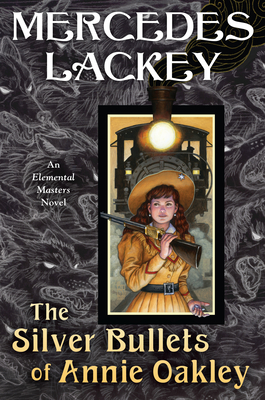 The Silver Bullets of Annie Oakley (Elemental Masters, #16) by Mercedes Lackey
The Silver Bullets of Annie Oakley (Elemental Masters, #16) by Mercedes Lackey Format: eARC
Source: supplied by publisher via Edelweiss
Formats available: hardcover, paperback, ebook
Genres: alternate history, fantasy, gaslamp, historical fantasy, steampunk
Series: Elemental Masters #16
Pages: 320
Published by DAW Books on January 11, 2022
Purchasing Info: Author's Website, Publisher's Website, Amazon, Barnes & Noble, Kobo, Bookshop.org
Goodreads
The sixteenth novel in the magical alternate history Elemental Masters series follows sharpshooter Annie Oakley as she tours Europe and discovers untapped powers.
Annie Oakley has always suspected there is something "uncanny" about herself, but has never been able to put a name to it. But when Buffalo Bill's Wild West Show goes on tour through Germany, Bill temporarily hires a new sharpshooter to be part of his "World Wide Congress of Rough Riders": a woman named Giselle, who also happens to be an Elemental Master of Air. Alongside this new performer, Annie discovers that she and her husband, Frank, are not simply master marksman, but also magicians of rare ability.
As they travel and perform, Annie must use her newfound knowledge and rare skill to combat creatures of the night scattered across the countryside, who threaten both the performers and the locals. Annie's got her gun, and it's filled with silver bullets.
My Review:
When I read the first few books in the Elemental Masters series – as they came out back in the early 2000s – I loved these retellings of classic fairy tales set in an alternate, slightly steampunkish late Victorian/early Edwardian era for the way that they mixed a bit of magic with a bit of alternate history to put a fresh face on a tale that was oh-so-familiar.
Now that I’m thinking about this the series is an alternate version of another of Lackey’s alternate ways of telling fairy tales, her Five Hundred Kingdoms series (begin with The Fairy Godmother) where the purpose of the story was to subvert the fairy tale to keep it from subverting someone’s life.
I digress.
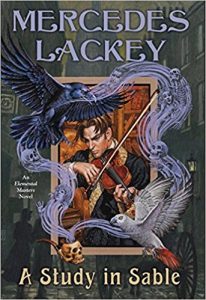 I stopped reading the Elemental Masters series after Reserved for the Cat as a consequence of the “so many books, so little time” conundrum that all of us who live in books are faced with so often. But I came back when the series switched from fairy tales to legendary characters with A Study in Sable and the three books that followed (A Scandal in Battersea, The Bartered Brides and The Case of the Spellbound Child) because the legendary character that was introduced and followed in this subseries of the series was none other than Sherlock Holmes.
I stopped reading the Elemental Masters series after Reserved for the Cat as a consequence of the “so many books, so little time” conundrum that all of us who live in books are faced with so often. But I came back when the series switched from fairy tales to legendary characters with A Study in Sable and the three books that followed (A Scandal in Battersea, The Bartered Brides and The Case of the Spellbound Child) because the legendary character that was introduced and followed in this subseries of the series was none other than Sherlock Holmes.
I can never resist a Holmes pastiche, and these were no exception.
But after following the “World’s Greatest Consulting Detective”, even an alternate version thereof, through an alternate version of Holmes’ London, the series took itself across the pond to the Americas while briefly turning to its roots of retelling fairy tales with Jolene. Which I have yet to read – even though just the title is giving me an earworm of Dolly Parton’s marvelous song – which I’m sure was the intention.
I was, however, all in to read this latest book in the series, The Silver Bullets of Annie Oakley, because I was wondering how the author would blend this historical character into this world where magic is hidden just beneath the surface.
It turns out that Annie Oakley herself, the real one, provided her own introduction to this world. As this story opens, we’re with Annie as she is in contracted servitude to a married couple she only refers to as “the Wolves” in her diary. Her real, historical diary.
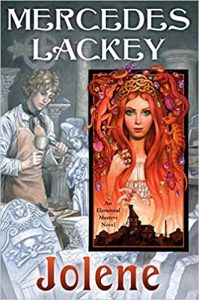 The Wolves – whose identity has never been conclusively determined – starved her, cheated her, threatened her and physically and mentally abused her at every turn for two years, beginning when Annie was nine years old.
The Wolves – whose identity has never been conclusively determined – starved her, cheated her, threatened her and physically and mentally abused her at every turn for two years, beginning when Annie was nine years old.
In this story, those two years of hell on earth become Annie’s introduction to the magic of this alternate world. Not just because the people she calls “the Wolves” turn out to be actual wolves – or rather werewolves – but because her desperate escape from the Wolves is facilitated by the magic of this alternate world – both the magic of the fairies AND magic of Annie’s very own.
After that shocking and heartbreaking beginning, the story shifts to Annie Oakley as an adult, the star of Buffalo Bill’s Wild West show, traveling in Europe.
Where she discovers that her childhood rescue by fairies was not the fever dream she tried to convince herself that it was. And that the magic she has hidden from herself all these years is hers to command – if she is willing to learn.
And that she’ll need all the training and assistance that she can get. Because the wolves are still after her.
Escape Rating A-: When I was growing up – back in the Dark Ages – there weren’t nearly enough biographies of women in my elementary school library. Honestly, there weren’t nearly enough, period. While there still aren’t, the situation has improved at least a bit.
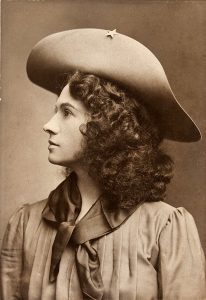
One of the few that was always available was Annie Oakley. It was easy to find stuff about her, and as someone who read as much of that library as humanly possible, I found what there was. She’s a fascinating person, as a woman in the late 19th and early 20th century who was famous for what she herself DID, and not for who she married, who she killed (I’m looking at you, Lizzie Borden) or who or what she was victimized by. Nor was she famous for her beauty. (I’ve included a picture to let you judge for yourself on that score, but whether you like her looks or not they are not what made her famous.
Her ability to shoot a gun, accurately and at a distance, is what made her famous. It also put food on the table when she was young and her family was broke.
Blending her real history and real talents into this magical story, and keeping reasonably close to what is known about her while expanding it into this created world was fascinating and fun. This was also a terrific story to get new readers into this long running series, as Annie is an adult when she finds out that she has magic, and her training in her newly discovered powers helps the reader get on board with the way that this world works AND is fascinating in its own right.
So this story’s blend of history with magic just plain worked for me – even more than I expected it to. More than enough to make me not miss the Sherlock Holmes of the earlier stories in the series too much.
Obviously, I really enjoyed this particular entry in this long-running series. MORE than enough that I’ll be back the next time the author returns to it. In the meantime, I have plenty of entries in the series that I missed to dip into whenever I’m looking for this blend of magic, myth and history.

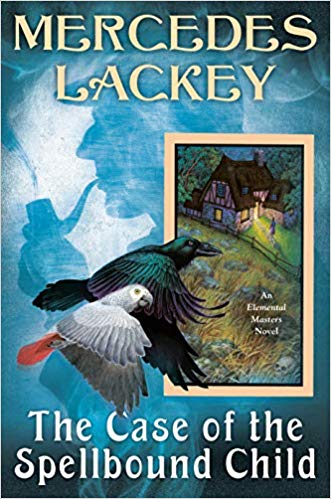 The Case of the Spellbound Child (Elemental Masters, #14) by
The Case of the Spellbound Child (Elemental Masters, #14) by 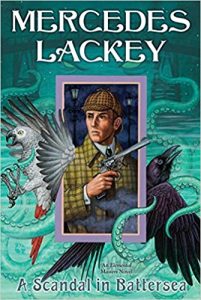 Escape Rating B+: If you look carefully at the background image in the book cover, you’ll recognize the silhouette of the famous detective, complete with pipe and just the suggestion of a deerstalker cap. It does lead one to believe that there will be more of Holmes than actually occurs in this case. On the other hand, there’s plenty of Watson, or rather, Watsons in this one, as the Wizard of London has tasked the Watsons with a case that he finds more important than the locals seem to.
Escape Rating B+: If you look carefully at the background image in the book cover, you’ll recognize the silhouette of the famous detective, complete with pipe and just the suggestion of a deerstalker cap. It does lead one to believe that there will be more of Holmes than actually occurs in this case. On the other hand, there’s plenty of Watson, or rather, Watsons in this one, as the Wizard of London has tasked the Watsons with a case that he finds more important than the locals seem to.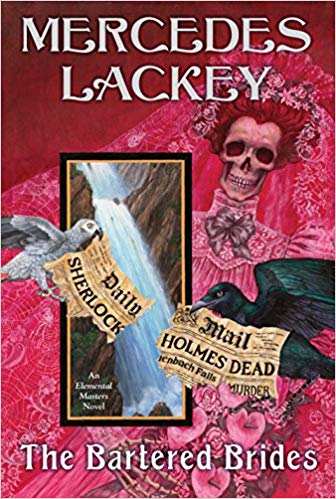 The Bartered Brides by
The Bartered Brides by 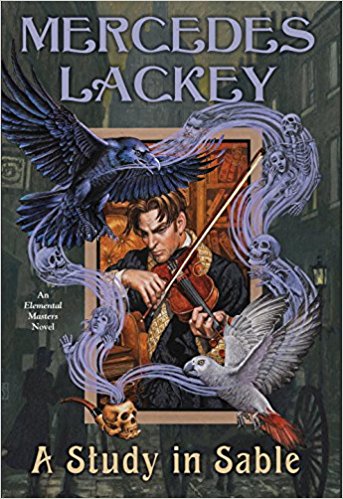 A Study in Sable (Elemental Masters #11) by
A Study in Sable (Elemental Masters #11) by 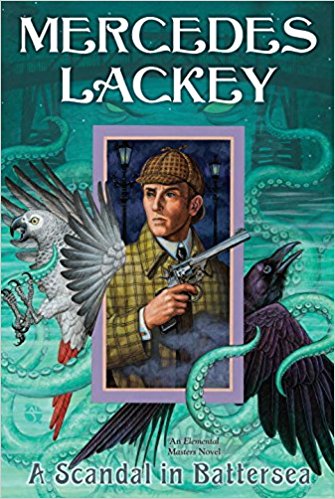 A Scandal in Battersea (Elemental Masters, #12) by
A Scandal in Battersea (Elemental Masters, #12) by